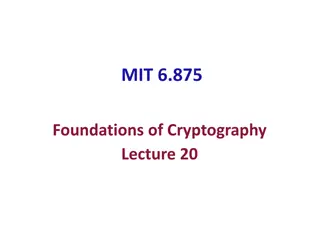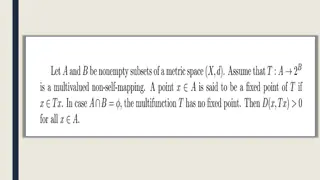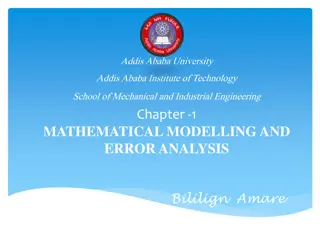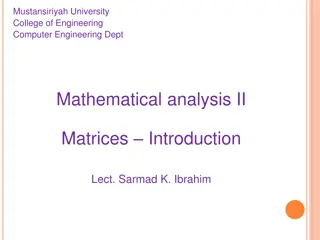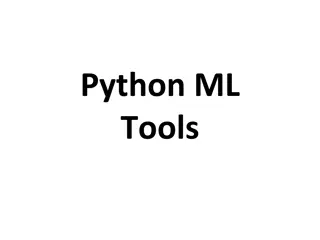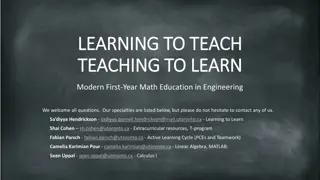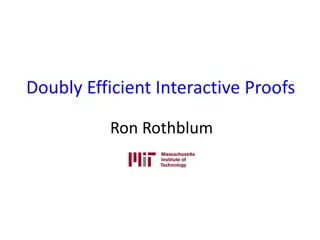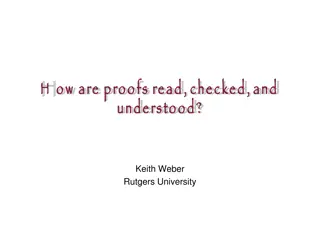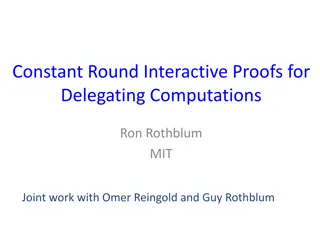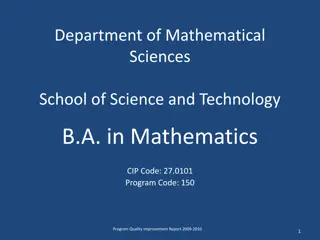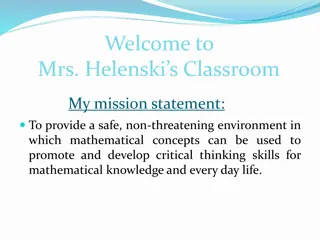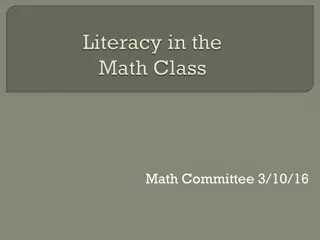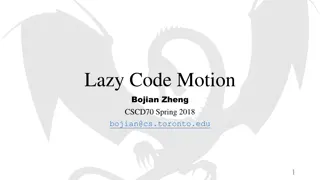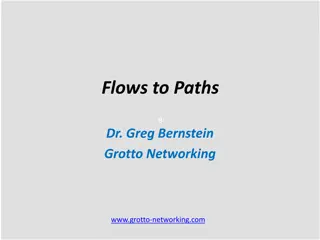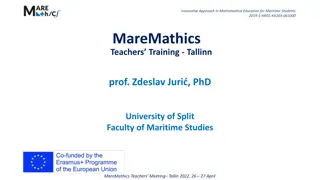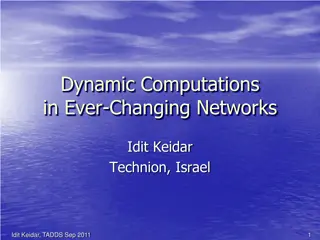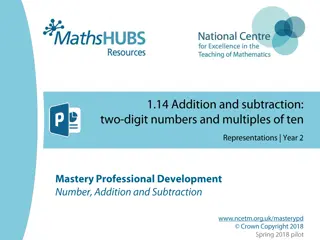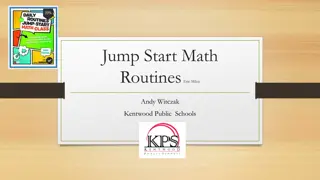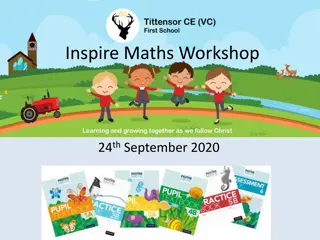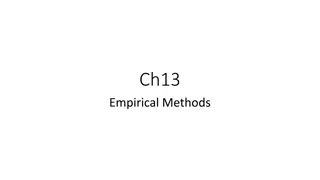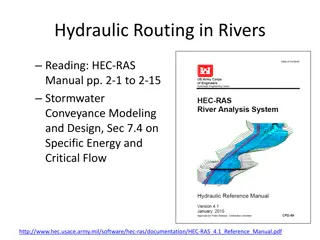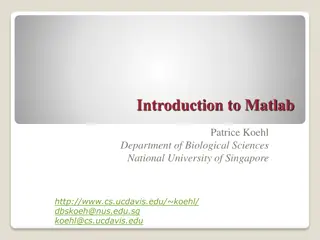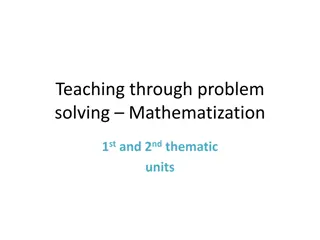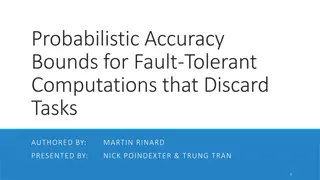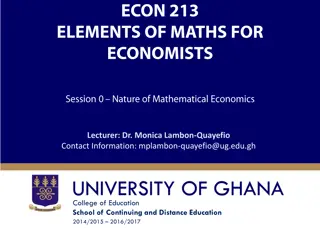Fully Homomorphic Encryption: Foundations and Applications
Fully Homomorphic Encryption (FHE) allows computations on encrypted data without decrypting, enabling secure outsourcing of computations to untrusted servers. FHE involves key generation, encryption, homomorphic evaluation, and decryption processes. It ensures correctness, security, and compactness
0 views • 31 slides
Mathematical Definitions and Theorems Illustrated
In this collection of images, various mathematical concepts are visually presented, including definitions, theorems, and proofs. The slides cover a range of topics in a structured manner, providing a concise overview of key mathematical principles. From foundational definitions to detailed proofs, t
0 views • 12 slides
Mathematical Modeling and Error Analysis in Engineering
Mathematical modeling plays a crucial role in solving engineering problems efficiently. Numerical methods are powerful tools essential for problem-solving and learning. This chapter explores the importance of studying numerical methods, the concept of mathematical modeling, and the evaluation proces
1 views • 10 slides
Introduction to Numpy and Scipy: Numerical Computing in Python
Numpy and Scipy provide powerful MATLAB-like functionality in Python for fast numerical computations, high-level math functions, and efficient handling of multidimensional arrays. Learn why NumPy is essential for speeding up numerical computations in Python and explore key features such as arrays, m
0 views • 47 slides
Mathematical Modeling and Error Analysis in Engineering
Mathematical modeling plays a crucial role in problem-solving in engineering by using numerical methods. This involves formulating problems for solutions through arithmetic operations. The study of numerical methods is essential as they are powerful problem-solving tools that enhance computer usage
5 views • 10 slides
Introduction to Matrices in Mathematical Analysis
Matrices play a crucial role in simplifying complex systems of equations and are well-suited for systematic mathematical treatments and computer computations. This introduction covers the definition of matrices, their properties such as size and notation, and various types of matrices including colu
0 views • 77 slides
Python ML Tools: NumPy and SciPy
Python is a powerful language for machine learning, but it can be slow for numerical computations. NumPy and SciPy are essential packages for working with matrices efficiently in Python. NumPy supports features crucial for machine learning, such as fast numerical computations and high-level math fun
2 views • 11 slides
Secure Multiparty Computation: Enhancing Privacy in Data Sharing
Secure multiparty computation (SMC) enables parties with private inputs to compute joint functions without revealing individual data, ensuring privacy and correctness. This involves computations on encrypted data using techniques like homomorphic encryption for scenarios like e-voting. SMC serves as
2 views • 27 slides
Advancements in Multi-Key Homomorphic Encryption Using TFHE
Revolutionary research has led to the development of Multi-Key Homomorphic Encryption (MKHE) from TFHE, enabling secure and efficient computations on encrypted data. This technology offers advantages such as dynamic operability, stronger security, and minimized interaction, making it an ideal soluti
0 views • 20 slides
Evolution of First-Year Math Education in Engineering
First-year math courses in engineering have undergone significant changes over the past decade, focusing on concepts over computations, promoting multiple paths to success, prioritizing qualitative results, incorporating mathematical modeling and problem-solving, enhancing collaboration and communic
1 views • 18 slides
Advancements in Interactive Proofs for Efficient Computation
Recent developments in interactive proofs focus on enhancing the efficiency of computations outsourced to untrusted servers, addressing concerns related to correctness and privacy. Solutions like doubly efficient interactive proofs offer a secure way to delegate computations while minimizing relianc
1 views • 25 slides
Checking Mathematical Proofs
Reading and understanding mathematical proofs involves careful analysis of logic and reasoning. Mathematicians and students use various strategies to ensure correctness, such as examining assumptions, following step-by-step logic, and verifying conclusions. This process is crucial for grasping the v
1 views • 79 slides
Constant Round Interactive Proofs for Delegating Computations
The research explores techniques for securely delegating computations to the cloud, addressing concerns of correctness and privacy through interactive proofs and efficient verification methods. It compares classical and doubly efficient interactive proofs, emphasizing the importance of computational
0 views • 43 slides
Metamath: A Computer Language for Mathematical Proofs
Metamath is a computer language designed for representing mathematical proofs. With several verifiers and proof assistants, it aims to formalize modern mathematics using a simple foundation. The Metamath-100 project is focused on proving a list of 100 theorems, with significant progress made in prov
2 views • 17 slides
Mathematics Program Quality Improvement Report 2009-2010 at Department of Mathematical Sciences
This report outlines the student-learning outcomes of the Mathematics program at the Department of Mathematical Sciences. It covers areas such as knowledge of mathematical content, reasoning and proof, mathematical representation and problem-solving, mathematical communication, and knowledge of tech
0 views • 29 slides
Enhancing Critical Thinking Skills Through Mathematical Concepts in Mrs. Helenski's Classroom
Mrs. Helenski's classroom provides a safe environment where mathematical concepts are utilized to develop critical thinking skills for both mathematical knowledge and everyday life. With a focus on promoting metacognition in Geometry Honors, students are challenged to apply, prove, justify, and expl
1 views • 20 slides
Mathematical Literacy and Its Importance in Education
Recognizing the language of mathematics, understanding symbols, and being able to explain solutions are key components of mathematical literacy. It goes beyond merely answering questions correctly to encompass explaining reasoning and exploring concepts actively. The Standards for Mathematical Pract
0 views • 36 slides
Lazy Code Motion and Partial Redundancy Elimination in Optimizing Compiler
Lazy code motion, partial redundancy elimination, common subexpression elimination, and loop invariant code motion are optimization techniques used in compilers to improve code efficiency by eliminating redundant computations and moving code blocks to optimize performance. These techniques aim to de
2 views • 35 slides
Floating Point Computations in Network Design Problems
Explore the challenges of working with numerical results in network design, including identifying essentially zero values and avoiding floating-point comparison pitfalls. Discover how to use machine epsilon for accurate computations and address common formulation issues in path optimization.
0 views • 15 slides
Innovative Approach in Mathematical Education for Maritime Students
Explore the innovative approach in mathematical education for maritime students as presented during the MareMathics Teachers Training and Meeting in Tallinn. The sessions covered topics such as mathematical applications in thermodynamics, including partial derivatives, derivations, and integrals wit
0 views • 11 slides
Mathematical Proofs and Concepts
Explore the world of mathematical proofs through chapters 4, 5, and 6. Delve into terminology, theorems, definitions, divisors, and accepted axioms used in mathematical reasoning. Discover the logic behind proofs and various methods employed in establishing the truth of mathematical statements.
2 views • 101 slides
Dynamic Computations in Ever-Changing Networks
Dynamic computations in ever-changing networks involve continuously adapting output to reflect input and environmental changes. This talk by Idit Keidar at TADDS Sep. 2011 explores the concept further, presenting examples like continuous weighted matching, live monitoring, and peer sampling. The dis
0 views • 51 slides
Tau vs. Pi: Embracing a New Constant in Math
The debate between Tau and Pi as fundamental mathematical constants, this content delves into the concept of Tau as the new circle constant. It discusses the relationship between Tau and Pi in various mathematical contexts, presenting key arguments for and against each constant. Through informative
0 views • 6 slides
Mathematical Operations Visualized
In this collection of visual representations of mathematical operations, calculations are brought to life with images and numbers. Explore addition, subtraction, multiplication, and more in a unique visual format that aids in understanding mathematical concepts. From simple equations to more complex
0 views • 43 slides
Jump Start Math Routines
This routine helps students with Mathematical Practices 2 and 7, focusing on efficient strategies, estimating, reasoning, and defending approaches in math computations. It involves whole-class discussions, identifying benchmarks, mental mathematics, sharing ideas, exploring reasoning, and confirming
0 views • 4 slides
Assembly of Tears: Week 7 Tutorial on Factorial Computations
Dive into the world of factorial computations with a focus on head and tail recursion techniques. Explore the toolbox for efficient coding practices and discover the power of implementing factorials using iterative, head, and tail recursion methods.
0 views • 27 slides
Is RRTMGP Suited for GPU?
RRTMGP offers the potential for significant speed-up on GPU due to its embarrassingly parallel nature and memory-intensive computations. The access patterns, memory performance, and scale dimensions also contribute to its suitability for GPU utilization. However, challenges are present in compiler c
1 views • 18 slides
Inspire Maths Workshop for Deepening Mathematical Thinking
At Tittensor First School, we implement Inspire Maths to enhance children's mathematical skills through a comprehensive primary maths program based on the renowned Singapore pedagogy. The C.P.A. approach (Concrete, Pictorial, Abstract) is used to foster a deeper understanding of mathematical concept
0 views • 11 slides
Introduction to Empirical Methods in Statistical Computations
This chapter explores various empirical methods used in statistical computations, serving as alternatives or enhancements to classical statistical methods. It covers topics such as the Jackknife Method, Bootstrap Methods, Expectation Maximization Algorithm, and Markov Chain Monte Carlo. These method
1 views • 46 slides
Analog Arithmetic Computation by CRNs: Biochemical Reaction Networks
This study explores the use of biochemical reaction networks to perform analog arithmetic computations such as addition, subtraction, multiplication, and division. The research delves into computing algebraic functions using CRNs, presenting innovative ways to leverage biological processes for mathe
0 views • 10 slides
Mastering Hydraulic Routing in Rivers: HEC-RAS Manual Insights
Dive deep into hydraulic routing in rivers with the HEC-RAS Manual, exploring topics like specific energy, critical flow, flood inundation, floodplain delineation, and steady flow solutions. Understand concepts such as flow conveyance, energy head loss, velocity coefficients, and solving steady flow
1 views • 12 slides
Real-Time Signal Processing in DSP Systems
Real-time DSP processing involves ensuring that all computations are completed within strict time constraints to maintain real-time performance, with exceptions for systems handling non-signal outputs. Differentiating between hard and soft real-time requirements, the processing of input samples must
0 views • 54 slides
Parameterized Diamond Tiling for Stencil Computations in Chapel
This project explores the development of efficient and adaptable code for high-performance computing using parameterized diamond tiling with Chapel parallel iterators. It addresses the challenges in software engineering for performance-driven code and the evolution of hardware systems. The research
0 views • 36 slides
Understanding Deep Learning Concepts in AI for Medicine Lecture
Explore the concepts of deep learning in AI for Medicine Lecture 21, focusing on computation graphs, forward propagation, and neural network computations. Dive into the flow of computations in neural networks and the significance of gradient descent. Get ready for the upcoming assignments and quizze
0 views • 60 slides
Introduction to MATLAB: High-Performance Language for Technical Computing
Learn about MATLAB, a high-performance language used for mathematical computations, algorithmic development, data analysis, and scientific graphics. Discover why MATLAB simplifies mathematical model analysis and provides professional-looking graphs with an extensible programming environment.
0 views • 28 slides
Matrix Computations in Convex Optimization Lecture by Ying Yuan
Explore matrix computations in convex optimization through lecture slides covering key concepts, direct vs. iterative methods, error and residual analysis, and more at the University of California, San Diego.
0 views • 39 slides
Exploring Mathematical Problem Solving Through Curriculum Analysis
Delve into the world of mathematical problem solving through an in-depth discussion on the definition of mathematical problems, the role of problem-solving in school textbooks, and the contributions of renowned figures like Polya. Explore various themes such as different types of math problems, open
0 views • 4 slides
MATLAB: A Powerful Software Environment for Numerical Computations
Discover the capabilities of MATLAB, a Matrix Laboratory software offering interactive numerical computations such as matrix operations, differential equations, optimization, signal processing, and more. Explore job opportunities and specialized toolboxes for signal processing, image processing, com
0 views • 24 slides
Probabilistic Accuracy Bounds for Fault-Tolerant Computations
Explore a novel approach utilizing task decomposition to handle errors in computations, enabling survival through faults while providing distortion bounds on output. This method utilizes a metalanguage to partition tasks and discard faulty ones, ensuring accurate results despite errors. Discover how
0 views • 13 slides
Understanding Mathematical Economics: Concepts and Applications
Explore the fundamental principles of mathematical economics, including the difference between mathematical and non-mathematical approaches, economic models, and key topics in economic analysis. Gain insights into how mathematical symbols and equations enhance reasoning and deductive processes in ec
0 views • 21 slides
